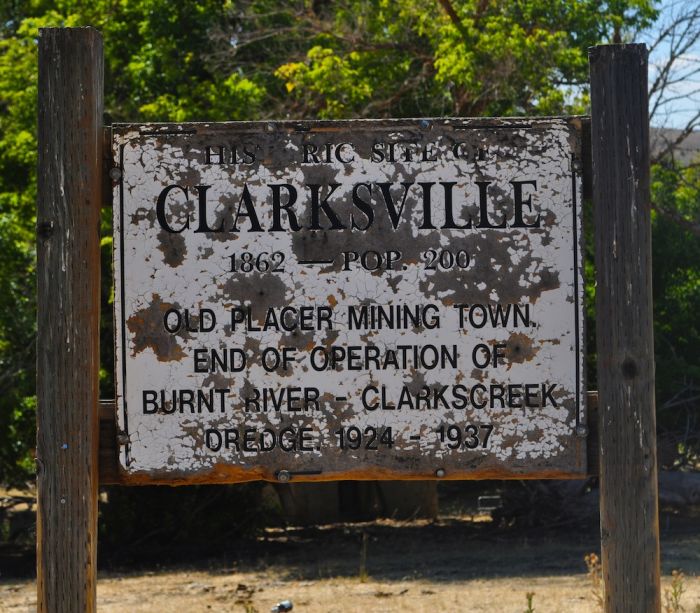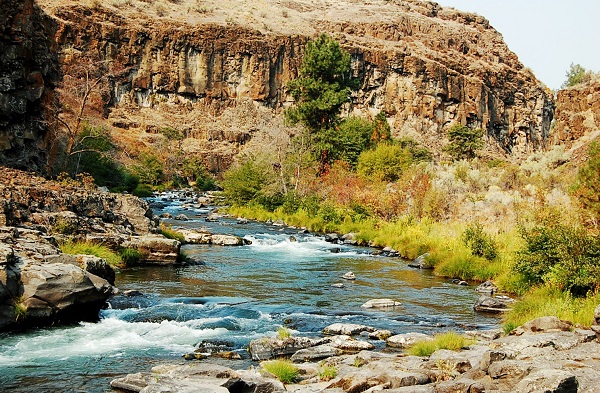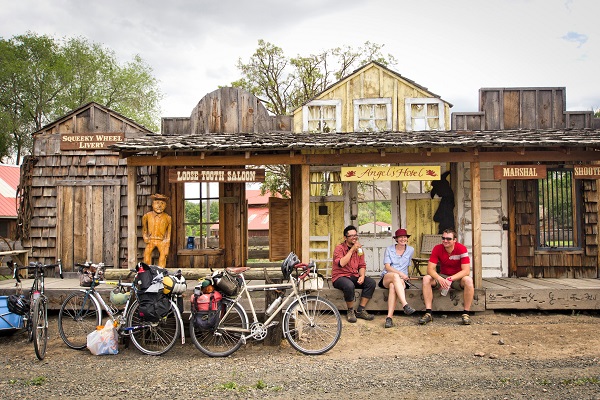A scan on the radio registers only static down in the canyon where the ghost town of Bridgeport lies. The pavement ends after the cell service, and a gravel road winds back up to the entry of Devil’s Canyon Ranch. A few tractors and trucks roll by, their drivers acknowledging passersby with the standard country two-finger wave. Mostly, though, its cows that make up the population of Baker County’s hilly landscape, where cattle ranching comprises about 80 percent of local livelihoods.
Suzan Jones navigates the rugged road into her 4,100-acre ranch on a four-wheeler. “I hope your car can make it,” she says. “The hail storm last July nearly washed out the road.” In her driveway, a stray red angus blocks the path to a historical marker of a long-disappeared town: Clarksville, Population 200 in 1862. A couple of miles down the gravel road, she comes to her home—a grand two story lodge-style house with solar panels. In this terrain, being off-the-grid is more a necessity than a form of environmental activism.
In 2009, Baker City natives Suzan Jones and her husband, Keith Jones, left their careers in the Department of Fish and Wildlife to build this home on property owned by her family since the 1960s. Her 91-year-old mother, known simply as BeBe, still lives independently a few miles down the road in Bridgeport.
In the winter, heavy snows often create a limited, but serene and peaceful life for the Joneses. “We feed cows in the morning, then move firewood and read,” says Jones. Still, different winters produce different lifestyles. Last winter, the snowplow lay dormant during a low precipitation season. In turn, one of their irrigation creeks dried up before the end of June. Other years, snow has kept the Joneses lodge-bound for days at a time. “It’s okay, though,” says Jones. “We chose this way of life. We go into town no more than once a week anyway.” Town is Baker City, where one of the couple’s two daughters, Kristen, and her family live. At over an hour’s drive, it’s the closest modern town to the ranch.
By 1900, Baker City was the largest city between Portland and Salt Lake City—all due to the burgeoning timber and gold industries, and boosted by railroad development. Today cattle massively outnumber the human population of nearly 10,000, but the shiny past is coming back to life in Baker County as gold prices continue to rise and adventurers get golden stars in their eyes. Two years ago, Midwestern businessman Philip Wirth bought the mineral rights to a lot of acreage in the Devil’s Canyon area. Teams of dredgers can now be found on properties around the county—some working on land owned by locals. What’s Baker County without its landuse conflict?
Logging is also a well-bantered topic in Baker County’s tree-covered landscape. Ranchers want to log portions of their property because of disease spreading in trees and fire hazards. Yet the disappearance of local mills and the slumping price of timber have made that infeasible.
The price of cattle, on the contrary, is “nice,” says Jones, who has seen the drought in the Midwest push the price of cattle near historic highs on the open market. This long-term drought is affecting key cattle grounds such as Texas, Oklahoma and Nebraska. Baker County, however, has fared better.
A financial cushion provided by their seventy head of cattle is helpful for the Jones’ broader plans. When they envisioned their home, it included a guest ranch. A portion of their lodge is already set up as a bed and breakfast for travelers looking to experience Western wilderness with unsurpassed authenticity. Also, they’ve plumbed sewage for five guest cabins that will become part of the larger build-out.
Back in Baker City, historic downtown is abuzz with First Friday festivities. Classic Victorian buildings from the late nineteenth and early twentieth century stand as an elegant reminder of the transient wealth of the gold rush era.
On Main Street, various businesses are now home to bustling art galleries, such as Peterson’s Gallery and Chocolatier. Just up the street, patrons dine and take overnight lodging at the iconic Geiser Grand Hotel, which Keith’s grandfather helped build in the 1880s.
Surrounding downtown in all directions are treasures for locals and tourists to discover. Oregon Trail greenhorns and experts can visit the Oregon Trail Interpretive Center east of town for living history exhibits and the deep ruts of the trail itself. No fewer than six museums are spread throughout town. Just outside of downtown, Geiser-Pollman Park honors pioneers with covered wagon displays along Powder River. Store clerks at adjacent York’s Covered Wagon even dress in period attire while doling out food and provisions.
The great outdoors beckons Oregon Trail enthusiasts, hunters and anglers. In the summer, the Baker City Cycling Classic draws throngs of professional and amateur cyclists. Winter brings sleigh rides and skiing. Just thirty-five minutes from town, Anthony Lakes Ski Resort offers shorter lift lines than its bigger Oregon counterparts, and is typically covered in a blanket of dry powder for much of the winter season. The vertical terrain can satisfy nearly any alpine snowbird or novice snowboarder.
Dining options are a bit scarce, but Paizano’s Pizza serves up foot-long slices of pie and comes highly recommended by locals. Downtown, Barley Brown’s Brew Pub’s award-winning beer has kept booths and barstools filled for fourteen years. On any given day, Barley Brown’s is running eleven taps of its brews. Tumble Off Pale Ale is named after a run at Anthony Lakes, and, to locals, is the town’s hoppy hero.
Head brewer, Eli Dickison, is a recent graduate of Oregon State University’s fermentation program. He worked at Barley Brown’s during his summer breaks and made his way up from prep cook to brewer. Dickison’s family has been in Baker City for five generations, and he was eager to continue the family legacy.
“It’s admittedly not a pumping metropolis,” says Dickison, his handlebar moustache part gold rush outlaw part Portland hipster stretches into a smile. “But I knew I wanted to come back here.”
Suzan and Keith Jones left their careers to return home and reignite the family ranch. Their daughter Kristen built a career she could pursue remotely, by starting her own publishing company, in order to move back to Baker City.
There is something to be said for generations coming home. Many small towns suffer when their youth flee the coop. The ever-present cultural heritage of Baker City, and the wildly beautiful hills and canyons, keep generations coming back and visitors feeling as though they’re just discovering the last frontier.









